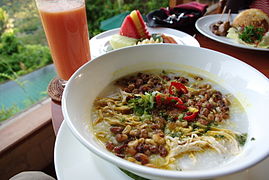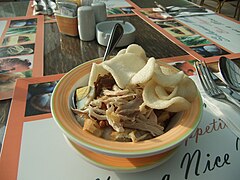Bubur ayam
 Bubur ayam, Indonesian chicken congee | |
| Course | Main, usually for breakfast or late night supper |
|---|---|
| Place of origin | Indonesia[1] |
| Region or state | Nationwide |
| Serving temperature | Hot |
| Main ingredients | Rice congee with chicken |
Bubur ayam (Indonesian for "chicken congee") is a Chinese Indonesian chicken congee. It is rice congee with shredded chicken meat served with some condiments, such as chopped scallion, crispy fried shallot, celery, tongcay (preserved salted vegetables), fried soybean, Chinese crullers (youtiao, known as cakwe in Indonesia), and both salty and sweet soy sauce, and sometimes topped with yellow chicken broth and kerupuk (Indonesian-style crackers). Unlike many other Indonesian dishes, it is not spicy; sambal or chili paste is served separately. It is a favourite breakfast food, served by humble travelling vendors, warung (small local shops), fast food establishments, and five-star hotel restaurants. Travelling bubur ayam vendors frequently pass through residential streets in the morning selling the dish.[1][2]
Origin and variations[]

The origin of bubur ayam was derived from Chinese chicken congee. The traces of Chinese cuisine influences are the use of cakwe (youtiao), tongcay and soy sauce. Bubur ayam employs a wide range of poultry products, such as shredded chicken meat for the main dish and different dishes made with chicken offal as side delicacies. Bubur ayam is often eaten with the addition of boiled chicken egg, chicken liver, gizzard, intestines and uritan (premature chicken eggs acquired from butchered hens), served as satay. There are some variants of bubur ayam, such as bubur ayam Bandung and bubur ayam Sukabumi, both from West Java.[3] The later variant uses raw telur ayam kampung (lit. "village chicken egg", i.e. free-range eggs) buried under the hot rice congee to allow the egg to be half-cooked, with the other ingredients on top of the rice congee.[4] The recipe and condiments of bubur ayam served by travelling vendors and warung are also slightly different with those served in fast food establishments or hotel restaurants.
Because this food is always served hot and with a soft texture, like soto ayam and nasi tim, bubur ayam is known as comfort food in Indonesian culture. The soft texture of the rice congee and boneless chicken also makes this dish suitable for young children or adults in convalescence. Because of its popularity, bubur ayam has become one of the Asia-inspired fast food menu items at McDonald's Indonesia[5] and Malaysia,[6] and also at Kentucky Fried Chicken Indonesia.[7] Although almost all recipes of bubur ayam use rice, a new variation, called bubur ayam havermut, replaces rice with oats.[8] In grocery stores, bubur ayam is also available as instant food, requiring only the addition of hot water.[9]
Gallery[]
Bubur ayam with premature chicken egg satay, sold in a warung in Jakarta.
Bubur ayam with chicken liver satay, a popular street food in Indonesia.
Bubur ayam served in Solo, Central Java.

Fast food Buryam, a bubur ayam served in McDonald's Indonesia.

Bubur ayam served for breakfast in a hotel in Bali.
See also[]
- Arroz caldo
- List of porridges
References[]
- ^ Jump up to: a b Kraig, Bruce; Sen, Colleen Taylor, eds. (2013). Street Food around the World: An Encyclopedia of Food and Culture. ABC-CLIO. ISBN 978-1598849547.
- ^ Tan, M G (2008). Etnis Tionghoa Di Indonesia: Kumpulan Tulisan. Yayasan Obor Indonesia. p. 115. ISBN 978-9794616895.
- ^ Dina Indrasafitri. "Bubur Ayam Sukabumi". Street Directory.com. Retrieved 2 June 2012.
- ^ Eka Septia Wulan (7 April 2011). "Unik Lezat, Bubur Ayam Manyar". detikFood.com. Retrieved 2 June 2012.
- ^ "Bubur Ayam". McDonald's Indonesia. Archived from the original on 3 April 2018. Retrieved 20 September 2015.
- ^ Michelle Woo (11 December 2009). "Happy Meals: 10 Asia-inspired fast food menu items". CNNGO.com. Archived from the original on 2012-05-15. Retrieved 2 June 2012.
- ^ "Bubur Ayam". KFC Indonesia. Archived from the original on 13 August 2009. Retrieved 2 June 2012.
- ^ "Bubur Ayam Havermut Nikmat dan Bergizi" (in Indonesian). Tribunnews.com. 28 April 2012. Retrieved 2 June 2012.
- ^ "Super Bubur Chicken - Instant Porridge". Asian Grocery Store. Retrieved 2 June 2012.
External links[]
| Wikimedia Commons has media related to Bubur ayam. |
- Bubur Ayam Sukabumi recipe (in Indonesian)
- Bubur Ayam Bandung recipe (in Indonesian)
- Bubur Ayam Jakarta recipe (in Indonesian)
- Indonesian chicken dishes
- Congee
- Indonesian Chinese cuisine
- Indonesian rice dishes
- Street food in Indonesia





